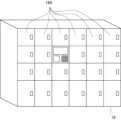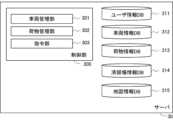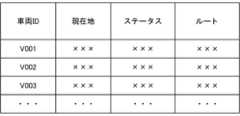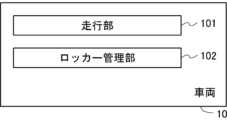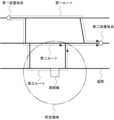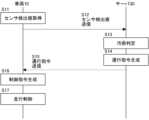JP7512988B2 - Information processing device, information processing method, and program - Google Patents
Information processing device, information processing method, and programDownload PDFInfo
- Publication number
- JP7512988B2 JP7512988B2JP2021159082AJP2021159082AJP7512988B2JP 7512988 B2JP7512988 B2JP 7512988B2JP 2021159082 AJP2021159082 AJP 2021159082AJP 2021159082 AJP2021159082 AJP 2021159082AJP 7512988 B2JP7512988 B2JP 7512988B2
- Authority
- JP
- Japan
- Prior art keywords
- vehicle
- predetermined
- information
- user
- route
- Prior art date
- Legal status (The legal status is an assumption and is not a legal conclusion. Google has not performed a legal analysis and makes no representation as to the accuracy of the status listed.)
- Active
Links
Images
Classifications
- G—PHYSICS
- G01—MEASURING; TESTING
- G01C—MEASURING DISTANCES, LEVELS OR BEARINGS; SURVEYING; NAVIGATION; GYROSCOPIC INSTRUMENTS; PHOTOGRAMMETRY OR VIDEOGRAMMETRY
- G01C21/00—Navigation; Navigational instruments not provided for in groups G01C1/00 - G01C19/00
- G01C21/26—Navigation; Navigational instruments not provided for in groups G01C1/00 - G01C19/00 specially adapted for navigation in a road network
- G01C21/34—Route searching; Route guidance
- G01C21/3407—Route searching; Route guidance specially adapted for specific applications
- G01C21/3415—Dynamic re-routing, e.g. recalculating the route when the user deviates from calculated route or after detecting real-time traffic data or accidents
- G—PHYSICS
- G05—CONTROLLING; REGULATING
- G05D—SYSTEMS FOR CONTROLLING OR REGULATING NON-ELECTRIC VARIABLES
- G05D1/00—Control of position, course, altitude or attitude of land, water, air or space vehicles, e.g. using automatic pilots
- G05D1/02—Control of position or course in two dimensions
- G05D1/021—Control of position or course in two dimensions specially adapted to land vehicles
- G05D1/0212—Control of position or course in two dimensions specially adapted to land vehicles with means for defining a desired trajectory
- G05D1/0217—Control of position or course in two dimensions specially adapted to land vehicles with means for defining a desired trajectory in accordance with energy consumption, time reduction or distance reduction criteria
- G—PHYSICS
- G05—CONTROLLING; REGULATING
- G05D—SYSTEMS FOR CONTROLLING OR REGULATING NON-ELECTRIC VARIABLES
- G05D1/00—Control of position, course, altitude or attitude of land, water, air or space vehicles, e.g. using automatic pilots
- G05D1/60—Intended control result
- G05D1/644—Optimisation of travel parameters, e.g. of energy consumption, journey time or distance
- G—PHYSICS
- G06—COMPUTING OR CALCULATING; COUNTING
- G06Q—INFORMATION AND COMMUNICATION TECHNOLOGY [ICT] SPECIALLY ADAPTED FOR ADMINISTRATIVE, COMMERCIAL, FINANCIAL, MANAGERIAL OR SUPERVISORY PURPOSES; SYSTEMS OR METHODS SPECIALLY ADAPTED FOR ADMINISTRATIVE, COMMERCIAL, FINANCIAL, MANAGERIAL OR SUPERVISORY PURPOSES, NOT OTHERWISE PROVIDED FOR
- G06Q10/00—Administration; Management
- G06Q10/20—Administration of product repair or maintenance
- G—PHYSICS
- G06—COMPUTING OR CALCULATING; COUNTING
- G06Q—INFORMATION AND COMMUNICATION TECHNOLOGY [ICT] SPECIALLY ADAPTED FOR ADMINISTRATIVE, COMMERCIAL, FINANCIAL, MANAGERIAL OR SUPERVISORY PURPOSES; SYSTEMS OR METHODS SPECIALLY ADAPTED FOR ADMINISTRATIVE, COMMERCIAL, FINANCIAL, MANAGERIAL OR SUPERVISORY PURPOSES, NOT OTHERWISE PROVIDED FOR
- G06Q30/00—Commerce
- G06Q30/02—Marketing; Price estimation or determination; Fundraising
- G06Q30/0207—Discounts or incentives, e.g. coupons or rebates
- G—PHYSICS
- G01—MEASURING; TESTING
- G01C—MEASURING DISTANCES, LEVELS OR BEARINGS; SURVEYING; NAVIGATION; GYROSCOPIC INSTRUMENTS; PHOTOGRAMMETRY OR VIDEOGRAMMETRY
- G01C21/00—Navigation; Navigational instruments not provided for in groups G01C1/00 - G01C19/00
- G01C21/26—Navigation; Navigational instruments not provided for in groups G01C1/00 - G01C19/00 specially adapted for navigation in a road network
- G—PHYSICS
- G06—COMPUTING OR CALCULATING; COUNTING
- G06Q—INFORMATION AND COMMUNICATION TECHNOLOGY [ICT] SPECIALLY ADAPTED FOR ADMINISTRATIVE, COMMERCIAL, FINANCIAL, MANAGERIAL OR SUPERVISORY PURPOSES; SYSTEMS OR METHODS SPECIALLY ADAPTED FOR ADMINISTRATIVE, COMMERCIAL, FINANCIAL, MANAGERIAL OR SUPERVISORY PURPOSES, NOT OTHERWISE PROVIDED FOR
- G06Q10/00—Administration; Management
- G06Q10/08—Logistics, e.g. warehousing, loading or distribution; Inventory or stock management
- G06Q10/083—Shipping
- G06Q10/08355—Routing methods
Landscapes
- Engineering & Computer Science (AREA)
- Business, Economics & Management (AREA)
- Physics & Mathematics (AREA)
- General Physics & Mathematics (AREA)
- Strategic Management (AREA)
- Radar, Positioning & Navigation (AREA)
- Remote Sensing (AREA)
- Entrepreneurship & Innovation (AREA)
- Economics (AREA)
- Development Economics (AREA)
- Human Resources & Organizations (AREA)
- Finance (AREA)
- Theoretical Computer Science (AREA)
- General Business, Economics & Management (AREA)
- Accounting & Taxation (AREA)
- Marketing (AREA)
- Automation & Control Theory (AREA)
- Aviation & Aerospace Engineering (AREA)
- Game Theory and Decision Science (AREA)
- Operations Research (AREA)
- Quality & Reliability (AREA)
- Tourism & Hospitality (AREA)
- Management, Administration, Business Operations System, And Electronic Commerce (AREA)
Description
Translated fromJapanese本開示は、情報処理装置、情報処理方法、及び、プログラムに関する。The present disclosure relates to an information processing device, an information processing method, and a program.
ロッカーに臭気センサを設け、臭気センサからの出力を用いることで、荷物が腐敗物の可能性や、劇物である可能性などを検査する技術が知られている(例えば、特許文献1参照。)。また、ストッカ納品庫に臭いを検知する気体センサを設け、センサの検出値が所定の閾値を超えたら異常と判断する技術が知られている(例えば、特許文献2参照。)。There is known technology that installs an odor sensor in a locker and uses the output from the odor sensor to check whether the luggage is putrid or a hazardous substance (see, for example, Patent Document 1). There is also known technology that installs a gas sensor that detects odors in a stocker delivery warehouse and determines that an abnormality has occurred if the sensor's detection value exceeds a predetermined threshold (see, for example, Patent Document 2).
ロッカーに臭い又は汚れが残っていると、ロッカーが使えなくなってしまったり、次に使う人が不快に思ったりする。本開示の目的は、格納装置に異常が発生したときに、異常をより速やかに解消することにある。If an odor or dirt remains in a locker, the locker may become unusable or the next person to use it may feel uncomfortable. The purpose of this disclosure is to quickly resolve an abnormality when it occurs in the storage device.
本開示の態様の一つは、
ユーザによる荷物の預け入れが可能な格納装置を搭載した車両を制御する制御部を有する情報処理装置であって、
前記制御部は、
前記荷物の預け入れ地点又は前記荷物の引き取り地点と、前記格納装置において前記荷物の格納に関連する所定の事象が発生した場合に前記所定の事象を解消可能な所定の場所を含む所定領域と、を経由するように、前記車両のルートを前記所定の事象が発生する前に生成すること、
を実行する情報処理装置である。 One aspect of the present disclosure is
An information processing device having a control unit that controls a vehicle equipped with a storage device in which a user can deposit baggage,
The control unit is
generating a route for the vehicle before a predetermined event occurs, the route passing through a drop-off point or a pick-up point of the baggage and a predetermined area including a predetermined location where a predetermined event related to the storage of the baggage can be resolved if the predetermined event occurs in the storage device;
The present invention is an information processing device that executes the above.
本開示の態様の一つは、
ユーザによる荷物の預け入れが可能な格納装置を搭載した車両を制御する制御方法であって、
コンピュータが、
前記荷物の預け入れ地点又は前記荷物の引き取り地点と、前記格納装置において前記荷物の格納に関連する所定の事象が発生した場合に前記所定の事象を解消可能な所定の場所を含む所定領域と、を経由するように、前記車両のルートを前記所定の事象が発生する前に生成すること、
を実行する情報処理方法である。 One aspect of the present disclosure is
A control method for controlling a vehicle equipped with a storage device in which a user can deposit baggage, comprising:
The computer
generating a route for the vehicle before a predetermined event occurs, the route passing through a drop-off point or a pick-up point of the baggage and a predetermined area including a predetermined location where a predetermined event related to the storage of the baggage can be resolved if the predetermined event occurs in the storage device;
It is an information processing method for performing the above.
本開示の態様の一つは、
ユーザによる荷物の預け入れが可能な格納装置を搭載した車両を制御するプログラムであって、
コンピュータに、
前記荷物の預け入れ地点又は前記荷物の引き取り地点と、前記格納装置において前記荷物の格納に関連する所定の事象が発生した場合に前記所定の事象を解消可能な所定の場所
を含む所定領域と、を経由するように、前記車両のルートを前記所定の事象が発生する前に生成させる、
プログラムである。 One aspect of the present disclosure is
A program for controlling a vehicle equipped with a storage device in which a user can deposit baggage,
On the computer,
generating a route for the vehicle before a predetermined event occurs, the route passing through a drop-off point or a pick-up point of the baggage and a predetermined area including a predetermined location where a predetermined event related to the storage of the baggage can be resolved if the predetermined event occurs in the storage device;
It is a program.
また、本開示の他の態様は、上記のプログラムを非一時的に記憶した記憶媒体である。Another aspect of the present disclosure is a storage medium that non-temporarily stores the above program.
本開示によれば、格納装置に異常が発生したときに、異常をより速やかに解消することができる。According to the present disclosure, when an abnormality occurs in a storage device, the abnormality can be resolved more quickly.
本開示の態様の一つである情報処理装置は、制御部を有する。制御部は、ユーザによる荷物の預け入れが可能な格納装置を搭載した車両を制御する。格納装置は車両に搭載されているため、車両の移動と共に格納装置も移動する。したがって、ユーザは、荷物を預け入れるとき又は荷物を引き取るときに車両ごと格納装置を呼び寄せることができる。そのため、ユーザは、荷物を預けたり引き取ったりするときに、長距離を移動する必要がない。An information processing device according to one aspect of the present disclosure has a control unit. The control unit controls a vehicle equipped with a storage device that allows a user to deposit luggage. Because the storage device is mounted on the vehicle, the storage device moves along with the movement of the vehicle. Therefore, a user can call for the storage device along with the vehicle when depositing or picking up luggage. Therefore, a user does not need to travel long distances when depositing or picking up luggage.
また、制御部は、荷物の預け入れ地点又は荷物の引き取り地点と、格納装置において荷物の格納に関連する所定の事象が発生した場合に所定の事象を解消可能な所定の場所を含む所定領域と、を経由するように車両のルートを、所定の事象が発生する前に生成する。所定の事象とは、例えば、預けた荷物に影響が及ぶ事象、または、荷物を預け入れたユーザに影響が及ぶ事象である。例えば、荷物に臭いが付いたり、荷物が汚れたり、荷物が濡れたり、ユーザが臭いを不快に感じたり、ユーザが汚れを不快に感じたりすることである。例えば、ユーザが預け入れた荷物から液体がこぼれたり、臭いが漏れたりして、格納装置にそれらが残ることが考えられる。格納装置に液体または臭いが残っていると、次に格納装置に預け入れた荷物にそれらが移る虞がある。この所定の事象は、所定の場所で解消することができる。所定の場所は、例えば、格納装置を清掃可能な場所としてもよい。The control unit also generates a route for the vehicle to pass through a baggage drop-off point or baggage pick-up point and a predetermined area including a predetermined location where a predetermined event related to the storage of baggage can be resolved if the predetermined event occurs in the storage device before the predetermined event occurs. The predetermined event is, for example, an event that affects the checked baggage or an event that affects the user who checked the baggage. For example, the baggage may become smelly, dirty, or wet, or the user may feel uncomfortable with the smell or feel uncomfortable with the dirt. For example, liquid may spill or odor may leak from the baggage checked by the user, and remain in the storage device. If liquid or odor remains in the storage device, there is a risk that it may be transferred to the next baggage checked in the storage device. This predetermined event can be resolved at the predetermined location. The predetermined location may be, for example, a location where the storage device can be cleaned.
ここで、格納装置に所定の事象が発生して所定の場所に移動する必要が生じたときに、所定の場所までの距離が長いと、所定の事象を解消するまでに時間がかかってしまう。そうすると、荷物の預け入れや荷物の引き取りに影響を及ぼす虞がある。また、所定の事象を解消するまで格納装置の利用を制限する場合には、格納装置の利用が制限されるため、収益が低下してしまう。When a specified event occurs in the storage device and it becomes necessary to move to a specified location, if the distance to the specified location is long, it will take a long time to resolve the specified event. This could affect baggage drop-off and collection. Furthermore, if the use of the storage device is restricted until the specified event is resolved, revenue will decrease because the use of the storage device will be restricted.
これに対して、所定の事象を解消可能な所定の場所を含む所定領域を車両が経由するように車両のルートを予め生成しておけば、所定の事象が発生したときに、すぐに所定の場所に移動することができる。所定領域は、所定の事象が発生したときに所定の事象を解消可能な場所まで移動するときに要する時間が、許容範囲内となるように定めてもよい。一方、所定領域を通過するために車両が遠回りをすると消費電力量の増加または消費燃料量の増加を招く。したがって、走行コストが許容範囲内となるように所定領域を定めてもよい。On the other hand, if a vehicle route is generated in advance so that the vehicle passes through a specified area that includes a specified location where the specified event can be resolved, the vehicle can move to the specified location immediately when the specified event occurs. The specified area may be determined so that the time required to move to a location where the specified event can be resolved when the specified event occurs is within an acceptable range. On the other hand, if the vehicle takes a detour to pass through the specified area, this will result in an increase in power consumption or fuel consumption. Therefore, the specified area may be determined so that the driving cost is within an acceptable range.
以下、図面に基づいて、本開示の実施の形態を説明する。以下の実施形態の構成は例示であり、本開示は実施形態の構成に限定されない。また、以下の実施形態は可能な限り組み合わせることができる。The following describes embodiments of the present disclosure with reference to the drawings. The configurations of the following embodiments are examples, and the present disclosure is not limited to the configurations of the embodiments. In addition, the following embodiments can be combined as much as possible.
<第1実施形態>
図1は、実施形態に係るシステム1の概略構成を示す図である。システム1は、ロッカー18を搭載する車両10にユーザが荷物を保管することが可能なシステムである。ユーザは、サーバ30を介して車両10を呼び出すことで、任意の地点において荷物の預け入れ、および、引き取りを行うことができる。車両10は、例えば自律走行可能な車両であるが、運転者による手動走行可能な車両であってもよく、車両10またはロッカー18を監視する管理者が乗車する車両であってもよい。First Embodiment
1 is a diagram showing a schematic configuration of a
ロッカー18は、複数の区画を有し、それぞれの区画に荷物を収納することができる装置である。図2に、ロッカー18の外観を示す。図示したように、ロッカー18は、複数の扉によってそれぞれの区画であるボックス180にアクセスできるよう構成される。システム1のユーザは、ユーザ端末20を用いて、または、ロッカー18に設けられたインタフェースを介して、指定されたボックス180の解錠操作を行うことができる。ロッカー18は、車両10の車室内に搭載される。なお、ロッカー18は格納装置の一例である。The
ユーザ端末20は、ユーザが所持する端末である。ユーザは、ユーザ端末20にインストールされている所定のアプリケーションを実行することで、車両10の呼び出し及びロッカーの施解錠を行うことができる。The
サーバ30は、車両10の運行を管理する装置である。サーバ30は、ユーザ端末20から、車両10の派遣要請を受けた場合に、当該ユーザの元へ派遣する車両10を決定し、当該車両10に対して運行を指示する。サーバ30は、ユーザが荷物を預け入れる地点、及び、ユーザが荷物を引き取る地点を車両10が経由して走行するように、車両10のルートを生成する。このルートは、所定領域を経由するように生成する。所定領域は、ロッカー18を清掃可能な場所である清掃場(所定の場所)を含む領域である。このルートは、ロッカー18に汚損等が発生するまでは、清掃場を経由するのではなく、清掃場に比較的近い所定領域を通過するルートである。このようなルートを車両10が走行することにより、車両10のロッカー18に汚損等が発生したときには、車両10を速やかに清掃場まで移動させることができる。The
そして、サーバ30は、ロッカー18に汚損が発生した場合に、車両10を清掃場に移動させて清掃員に清掃をさせる。清掃場には、自動車販売店、自動車整備工場、ガソリンスタンド、または、登録されたユーザの自宅を例示できる。清掃場では、清掃員が清掃場端末40を用いて、または、ロッカー18に設けられたインタフェースを介して、清掃するボックス180の解錠操作を行うことができる。清掃場端末40は、清掃場で清掃員が利用する端末である。清掃員は、清掃場端末40にインストールされている所定のアプリケーションを実行することで、ロッカーの施解錠を行うことができる。清掃員には、自動車販売店の従業員、自動車整備工場の従業員、ガソリンスタンドの従業員、または、登録されたユーザを例示できる。When the
車両10、ユーザ端末20、サーバ30、及び、清掃場端末40は、ネットワークN1によって相互に接続されている。ネットワークN1は、例えば、インターネット等の世界規模の公衆通信網でありWAN(Wide Area Network)やその他の通信網が採用されてもよい。また、ネットワークN1は、携帯電話等の電話通信網、または、Wi-Fi(登録商標)等の無線通信網を含んでもよい。また、ロッカー18は、近距離無線通信等を含むネットワークN2を介して、ユーザ端末20及び清掃場端末40に接続される。ネットワークN2は、例えば、Bluetooth(登録商標)LowEnergy、NFC(Near Field Communication)、UWB(Ultra Wideband)、Wi-Fi(登録商標)などを利用してデータ通信を行う。The
図3に基づいて、車両10、ユーザ端末20、サーバ30、及び、清掃場端末40のハードウェア構成及び機能構成について説明する。図3は、本実施形態に係るシステム1を構成する車両10、ユーザ端末20、サーバ30、及び、清掃場端末40のそれぞれの構成の一例を概略的に示すブロック図である。The hardware configuration and functional configuration of the
サーバ30は、コンピュータの構成を有している。サーバ30は、プロセッサ31、主記憶部32、補助記憶部33、及び、通信部34を有する。これらは、バスにより相互に接続される。プロセッサ31は、制御部の一例である。主記憶部32及び補助記憶部33は、記憶部の一例である。The
プロセッサ31は、CPU(Central Processing Unit)やDSP(Digital Signal Processor)等である。プロセッサ31は、サーバ30を制御し、様々な情報処理の演算を
行う。主記憶部32は、RAM(Random Access Memory)、ROM(Read Only Memory)等である。補助記憶部33は、EPROM(Erasable Programmable ROM)、ハードディ
スクドライブ(HDD、Hard Disk Drive)、リムーバブルメディア等である。補助記憶
部33には、オペレーティングシステム(Operating System :OS)、各種プログラム、各種テーブル等が格納される。補助記憶部33に格納されたプログラムをプロセッサ31が主記憶部32の作業領域にロードして実行し、このプログラムの実行を通じて各構成部等が制御される。これにより、所定の目的に合致した機能をサーバ30が実現する。主記憶部32および補助記憶部33は、コンピュータで読み取り可能な記録媒体である。なお、サーバ30は、単一のコンピュータであってもよいし、複数台のコンピュータが連携したものであってもよい。また、補助記憶部33に格納される情報は、主記憶部32に格納されてもよい。また、主記憶部32に格納される情報は、補助記憶部33に格納されてもよい。 The
通信部34は、ネットワークN1経由で、車両10、ユーザ端末20、及び、清掃場端末40と通信を行う手段である。通信部34は、例えば、LAN(Local Area Network)インターフェースボード、無線通信のための無線通信回路である。LANインターフェースボードや無線通信回路は、ネットワークN1に接続される。The
次に、車両10は、例えば自律的に走行可能な移動体であり、コンピュータを有している。車両10は、プロセッサ11、主記憶部12、補助記憶部13、通信部14、位置情報センサ15、環境情報センサ16、駆動部17、及び、ロッカー18を有する。これらは、バスにより相互に接続される。プロセッサ11、主記憶部12、及び、補助記憶部13は、サーバ30のプロセッサ31、主記憶部32、及び、補助記憶部33と同様であるため、説明を省略する。Next, the
通信部14は、車両10をネットワークN1に接続するための通信手段である。通信部14は、例えば、移動体通信サービス(例えば、5G(5th Generation)、4G(4th Generation)、3G(3rd Generation)、LTE(Long Term Evolution)等の電話通信網
)、Wi-Fi(登録商標)、または、Bluetooth(登録商標)等の無線通信を利用して、ネットワークN1経由で他の装置(例えばサーバ30等)と通信を行うための回路である。 The
位置情報センサ15は、所定の周期で、車両10の位置情報(例えば緯度、経度)を取得する。位置情報センサ15は、例えば、GPS(Global Positioning System)受信部
、無線通信部等である。位置情報センサ15で取得された情報は、例えば、補助記憶部13等に記録され、サーバ30に送信される。 The
環境情報センサ16は、車両10の状態をセンシングしたり、または、車両10の周辺をセンシングしたりする手段である。車両10の状態をセンシングするためのセンサとして、ジャイロセンサ、加速度センサ、または、方位角センサが挙げられる。車両10の周辺をセンシングするためのセンサとして、ステレオカメラ、レーザスキャナ、LIDAR、または、レーダなどが挙げられる。The
駆動部17は、プロセッサ11が生成した制御指令に基づいて、車両10を走行させるための装置である。駆動部17は、例えば、車両10が備えるロータを駆動するための複数のモータ等を含んで構成され、制御指令に従って複数のモータ等が駆動されることで、車両10の自律走行が実現される。The
ロッカー18は、ユーザの荷物を預かる装置である。ロッカー18は、ユーザの荷物を格納する複数のボックス180を有しており、各ボックス180には、内部の臭気または汚れを検出する汚損センサ181が備わる。また、ロッカー18は、入出力部182及び通信部183を有する。汚損センサ181、入出力部182及び通信部183は、バスにより車両10のプロセッサ11等と接続されている。The
汚損センサ181は、臭気成分を検出可能なセンサ、汚れを検出可能なセンサ、または、液体を検出可能なセンサのうちの1つ以上のセンサを含んでいる。臭気成分を検出可能なセンサは、例えば臭気の強さを検出可能な臭気センサである。また、汚れを検出可能なセンサは、例えば、カメラ(イメージセンサ)を備えたセンサであり、例えば、撮像した画像データに基づいて汚れの程度を検出するセンサである。液体を検出可能なセンサは、例えば、光の透過率若しくは反射率の変化を検出することで液体を検出する漏液センサ、または、電気抵抗の変化を検出することで液体を検出する漏液センサなどである。これらセンサは、複数を組み合わせて利用するこができる。なお、別法として、汚損センサ181は、液体がこぼれ得る状態になったことを検出するセンサであってもよい。例えば、汚損センサ181にジャイロセンサを採用し、ジャイロセンサの検出値が液体のこぼれ得る値になった場合に、液体を検出したとみなしてもよい。The soiling
入出力部182は、ユーザが行った入力操作を受け付け、ユーザに対して情報を提示するユニットである。本実施形態では一つのタッチパネルディスプレイからなる。また、入
出力部182は、ユーザ端末20との間で認証情報を交換するためのさらなる手段を有していてもよい。例えば、二次元バーコードを読み取るためのカメラなどを有していてもよい。 The input/
通信部183は、ロッカー18をネットワークN2に接続するための通信手段である。通信部183は、例えば、Bluetooth(登録商標)LowEnergy、NFC(Near Field Communication)、UWB(Ultra Wideband)、Wi-Fi(登録商標)等の無線通信網を利用して、ネットワークN2経由で他の装置(例えばユーザ端末20または清掃場端末40等)と通信を行うための回路である。The
次に、ユーザ端末20について説明する。ユーザ端末20は、例えば、スマートフォン、携帯電話、タブレット端末、個人情報端末、ウェアラブルコンピュータ(スマートウォッチ等)、パーソナルコンピュータ(Personal Computer、PC)といった小型のコンピュータである。ユーザ端末20は、プロセッサ21、主記憶部22、補助記憶部23、入力部24、ディスプレイ25、及び、通信部26を有する。これらは、バスにより相互に接続される。プロセッサ21、主記憶部22、補助記憶部23については、サーバ30のプロセッサ31、主記憶部32、補助記憶部33と同様であるため、説明を省略する。Next, the
入力部24は、ユーザが行った入力操作を受け付ける手段であり、例えば、タッチパネル、マウス、キーボード、または、押しボタン等である。ディスプレイ25は、ユーザに対して情報を提示する手段であり、例えば、LCD(Liquid Crystal Display)、または、EL(Electroluminescence)パネル等である。入力部24及びディスプレイ25は、
1つのタッチパネルディスプレイとして構成してもよい。 The
It may be configured as a single touch panel display.
通信部26は、ユーザ端末20をネットワークN1またはネットワークN2に接続するための通信手段である。通信部26は、例えば、移動体通信サービス(例えば、5G(5th Generation)、4G(4th Generation)、3G(3rd Generation)、LTE(Long Term Evolution)等の電話通信網)、Wi-Fi(登録商標)、Bluetooth(登録
商標)LowEnergy、NFC(Near Field Communication)、UWB(Ultra Wideband)、等の無線通信網を利用して、ネットワークN1またはネットワークN2経由で他の装置(例えば車両10、ロッカー18、または、サーバ30等)と通信を行うための回路である。 The
次に、清掃場端末40について説明する。清掃場端末40は、例えば、スマートフォン、携帯電話、タブレット端末、個人情報端末、ウェアラブルコンピュータ(スマートウォッチ等)、パーソナルコンピュータ(Personal Computer、PC)といった小型のコンピュータである。清掃場端末40は、プロセッサ41、主記憶部42、補助記憶部43、入力部44、ディスプレイ45、及び、通信部46を有する。これらは、バスにより相互に接続される。なお、これらの構成は、ユーザ端末20のプロセッサ21、主記憶部22、補助記憶部23、入力部24、ディスプレイ25、及び、通信部26と同様であるため、説明を省略する。Next, the
次に、サーバ30の機能について説明する。図4は、サーバ30の機能構成を例示した図である。サーバ30は、機能構成要素として、制御部300、ユーザ情報DB311、車両情報DB312、荷物情報DB313、清掃場情報DB314、及び、地図情報DB315を備える。サーバ30のプロセッサ31は、主記憶部32上のコンピュータプログラムにより、制御部300の処理を実行する。ただし、各機能構成素のいずれか、またはその処理の一部がハードウェア回路により実行されてもよい。制御部300には、車両管理部301、荷物管理部302、及び、指令部303が含まれる。Next, the functions of the
ユーザ情報DB311、車両情報DB312、荷物情報DB313、清掃場情報DB314、及び、地図情報DB315は、プロセッサ31によって実行されるデータベース管理システム(Database Management System、DBMS)のプログラムが、補助記憶部33に記憶されるデータを管理することで構築される。ユーザ情報DB311、車両情報DB312、荷物情報DB313、清掃場情報DB314、及び、地図情報DB315は、例えば、リレーショナルデータベースである。The user information DB311, vehicle information DB312, baggage information DB313, cleaning site information DB314, and map information DB315 are constructed by a database management system (DBMS) program executed by the
なお、サーバ30の各機能構成要素のいずれか、またはその処理の一部は、ネットワークN1に接続される他のコンピュータにより実行されてもよい。In addition, any of the functional components of
車両管理部301は、車両10に関する情報を収集し、後述の車両情報DB312を更新する。具体的には、車両管理部301は、複数の車両10と周期的に通信を行い、車両10に関する情報(以下、車両情報ともいう。)を収集する。収集した情報は、後述する車両情報DB312に反映される。The
荷物管理部302は、荷物の預け入れを希望するユーザからの預け入れ要求を取得する。預け入れ要求とは、ユーザの希望する地点に荷物を預け入れる車両10を呼び出すための情報である。預け入れ要求は、ユーザ端末20からサーバ30に送信される。預け入れ要求には、ユーザID、預け入れ地点、預け入れ日時、及び、荷物の大きさ等に関する情報が含まれる。ユーザIDは、ユーザに固有な識別子である。ユーザIDに対応するユーザ情報(例えば、氏名、住所、電話番号、e-mailアドレス等)は、予めユーザがユ
ーザ端末20を用いて登録してもよく、または、預け入れ要求と共にユーザ端末20から送信されてもよい。このユーザ情報は、ユーザ情報DB311に格納されている。ユーザ情報DB311は、上記の補助記憶部33にユーザ情報が格納されて形成されており、そこではユーザとユーザ情報の紐付けが行われている。預け入れ地点は、ユーザが車両10のロッカー18に荷物を預け入れることを希望する地点であり、例えば、座標(緯度及び経度)、住所、又は、建物の名称などによって示される。預け入れ日時は、ユーザが車両10のロッカーに荷物を預け入れることを希望する日時である。なお、預け入れ日時は、ある程度の幅を持った時間帯として指定してもよい。 The
また、荷物管理部302は、荷物の引き取りを希望するユーザからの引き取り要求を取得する。引き取り要求とは、荷物を引き取る目的のために、ユーザの希望する地点に荷物を載せた車両10を呼び出すための情報である。引き取り要求は、ユーザ端末20からサーバ30に送信される。引き取り要求には、ユーザID、引き取り地点、引き取り日時等に関する情報が含まれる。引き取り地点は、ユーザが車両10のロッカー18から荷物を引き取ることを希望する地点であり、例えば、座標(緯度及び経度)、住所、又は、建物の名称などによって示される。引き取り日時は、ユーザが車両10のロッカー18から荷物を引き取ることを希望する日時である。なお、引き取り日時は、ある程度の幅を持った時間帯として指定してもよい。また、引き取り要求は、預け入れ要求と同時にユーザ端末20から送信されてもよく、預け入れ要求の後に、引き取り要求がユーザ端末20から送信されてもよい。The
荷物管理部302は、預け入れ要求に含まれる情報、及び、引き取り要求に含まれる情報を後述する荷物情報DB313に格納する。The
指令部303は、預け入れ要求または引き取り要求を受信した場合に、荷物の預け入れまたは引き取りを行う地点(すなわち、車両10を派遣する地点。以下、派遣地点)、および、その日時(以下、派遣日時)を決定し、車両10を運行させるための指令である運行指令を生成する。運行指令には、例えば、車両10のルートが含まれる。When the
また、指令部303は、清掃場を含む所定領域を経由するように車両10のルートを生成する。所定領域は、例えば、清掃場から所定の距離内の領域である。指令部303は、例えば預け入れ要求及び引き取り要求に基づいて仮ルートを生成し、仮ルートが所定領域を通過しない場合には、所定領域を通過するように新たにルートを生成し直す。このときに、指令部303は、例えば、仮ルートと所定領域との距離が、最も短くなる清掃場を抽出し、その所定領域を通り且つ移動距離が最も短くなるように新たなルートを設定してもよい。なお、所定領域は、派遣地点と派遣地点との間に夫々位置するようにルートを生成してもよく、複数の派遣地点ごとに位置するようにルートを生成してもよい。The
また、仮ルートの近くに清掃場がない場合には、所定領域を通過するルートを無理に生成しなくてもよい。例えば、新たなルートと仮ルートの移動距離の差が所定距離以上ある場合、または、新たなルートと仮ルートとの走行時間の差が所定時間以上ある場合には、所定領域を通過する新たなルートを採用しなくてもよい。ここでいう所定距離及び所定時間は、コストまたは許容される時間に基づいて決定してもよい。なお、距離又は時間の差の代わりに、距離又は時間の比に基づいて判断してもよい。Also, if there is no cleaning site near the tentative route, it is not necessary to forcefully generate a route that passes through a specified area. For example, if the difference in travel distance between the new route and the tentative route is equal to or greater than a specified distance, or if the difference in driving time between the new route and the tentative route is equal to or greater than a specified time, it is not necessary to adopt a new route that passes through a specified area. The specified distance and specified time referred to here may be determined based on cost or allowable time. Note that instead of the difference in distance or time, a determination may be made based on the ratio of distance or time.
指令部303は、地図情報DB315に格納されている地図情報に基づいてルートを生成する。指令部303は、例えば、車両10が、現在地から出発して、各派遣地点を派遣日時に経由して走行し、且つ、途中で所定領域を経由するように運行指令を生成する。また、運行指令には、各派遣地点において、ユーザから荷物を預かる指令、または、ユーザに荷物を引き渡す指令が含まれる。The
指令部303は、例えば、ユーザから預け入れ要求を受信した場合には、預け入れ要求に含まれる預け入れ地点、預け入れ日時、及び、荷物の大きさなどの情報に基づいて、派遣可能な車両10を選定する。派遣可能な車両10は、該当する大きさの荷物を預け入れ可能なボックス180の空きがあり、且つ、預け入れ日時に預け入れ地点に移動可能な車両である。例えば、同じ日時に他の場所で荷物の預け入れ又は引き取りの予約が入っている車両は、預け入れ日時に預け入れ地点に移動可能な車両10には該当しない。したがって、他の荷物に対応した派遣地点及び派遣日時に応じて、車両10を選定する。なお、ユーザが希望する預け入れ日時に派遣可能な車両10が存在しない場合には、荷物を預け入れできないことをユーザ端末20に通知してもよい。このときに、預け入れ地点において荷物を預けることができる日時をユーザ端末20に通知してもよい。For example, when the
なお、上記説明では、預け入れ要求に預け入れ日時が含まれているが、これに限らず、サーバ30からユーザに預け入れ日時を提示してもよい。例えば、サーバ30が預け入れ地点を取得した場合に、ボックス180の予約状況に基づいて荷物を預け入れ可能な日時を取得し、その預け入れ可能な日時をユーザ端末20へ通知してもよい。預け入れ可能な日時が複数存在する場合には、複数の預け入れ可能な日時をユーザに提示してもよい。このようにして、ユーザが複数の預け入れ可能な日時の中から選択できるようにしてもよい。同様に、預け入れ要求に預け入れ地点を含めずに、サーバ30からユーザに預け入れ地点を提示してもよい。さらに、別法として、サーバ30からユーザに預け入れ地点及び預け入れ日時を提示してもよい。In the above description, the deposit request includes the deposit date and time, but this is not limiting, and the
また、指令部303は、例えば、ユーザから引き取り要求を受信した場合には、引き取り要求に含まれるユーザID、引き取り地点、及び、引き取り日時などの情報に基づいて、派遣する車両10を選定する。このときに派遣する車両10は、ユーザが既に荷物を預けている車両である。したがって、ユーザIDに基づいてユーザが既に荷物を預けている車両10を特定する。そして、指令部303は、引き取り要求に含まれる引き取り地点及び引き取り日時に基づいて、その引き取り日時に引き取り地点に車両10を派遣可能か否
か判定する。なお、ユーザが希望する引き取り日時に車両10を派遣できない場合には、その引き取り日時にその引き取り地点で荷物の引き渡しができないことをユーザ端末20に通知してもよい。このときに、引き取り地点において荷物を引き渡すことができる日時をユーザ端末20に通知してもよい。 In addition, for example, when the
なお、上記説明では、引き取り要求に引き取り日時が含まれているが、これに限らず、サーバ30からユーザに引き取り日時を提示してもよい。例えば、サーバ30が引き取り地点を取得した場合に、ボックス180の予約状況に基づいて荷物を引き取り可能な日時を取得し、その引き取り可能な日時をユーザ端末20へ通知してもよい。引き取り可能な日時が複数存在する場合には、複数の引き取り可能な日時をユーザに提示してもよい。このようにして、ユーザが複数の引き取り可能な日時の中から選択できるようにしてもよい。同様に、引き取り要求に引き取り地点を含めずに、サーバ30からユーザに引き取り地点を提示してもよい。さらに、別法として、サーバ30からユーザに引き取り地点及び引き取り日時を提示してもよい。In the above description, the pickup request includes the pickup date and time, but this is not limiting, and the
また、荷物管理部302は、車両10から汚損センサ181の検出値を取得する。汚損センサ181の検出値は、例えば、車両10から定期的に送信される車両情報に含まれる。そして、汚損センサ181の検出値が、清掃が必要とされる値を示している場合に、車両10に対して次に通過する所定領域に含まれる清掃場に向かう指令を送信する。荷物管理部302は、例えば、汚損センサ181の検出値を3つの汚損レベルに分けて、各レベルに応じた処理を実行する。例えば、3つのレベルは、清掃の必要がない第一レベル、清掃の必要はあるが汚損の程度が低い第二レベル、及び、汚損の程度が高い第三レベルであってもよい。なお、レベル分けは3つに限らず、2つであってもよく、4つ以上であってもよい。The
また、第二レベルは、簡単な清掃で済むレベルとしてもよい。簡単な清掃とは、例えば、所定の時間未満に完了可能な清掃、または、家庭レベルの清掃道具を用いた清掃であってもよい。一方、清掃に所定時間以上要する場合には、第三レベルとしてもよい。第三レベルは、特別な清掃が必要なレベルとしてもよい。特別な清掃とは、一般家庭にはないような道具または薬品などを利用する清掃である。また、例えば、汚損センサ181の検出値が、第一閾値未満の場合には第一レベルとし、第一閾値以上第二閾値未満の場合には第二レベルとし、第二閾値以上の場合には第三レベルとしてもよい。すなわち、汚損センサ181の検出値が大きいほど、清掃に時間がかかるものとして汚損レベルを設定してもよい。The second level may be a level that requires simple cleaning. Simple cleaning may be, for example, cleaning that can be completed in less than a predetermined time, or cleaning using household cleaning tools. On the other hand, when cleaning requires more than a predetermined time, the third level may be used. The third level may be a level that requires special cleaning. Special cleaning is cleaning that uses tools or chemicals that are not found in ordinary households. For example, the first level may be used when the detection value of the soiling
また、汚損センサ181によって液体を検出した場合には、少なくとも第二レベルまたは第三レベルに相当するように、第一閾値及び第二閾値が設定されてもよい。また、第一閾値を、該当するボックス180から液体が流れ出ない程度の値に設定し、第二閾値を、該当するボックス180から液体が流れ出る可能性のある値に設定してもよい。In addition, when liquid is detected by the
また、汚損センサ181によって汚れを検出した場合には、すぐに除去できない汚れの場合に汚損レベルが第三レベルであると決定してもよい。汚れの種類又は程度は、例えば、画像処理により判別してもよい。In addition, when dirt is detected by the
荷物管理部302は、ボックス180に対応する汚損レベルについての情報を、後述する荷物情報DB313に格納する。The
次に、車両情報DB312に格納される車両情報の構成について、図5に基づいて説明する。図5は、車両情報DB312のテーブル構成を例示した図である。車両情報テーブルは、車両ID、現在地、ステータス、及び、ルートの各フィールドを有する。車両ID
フィールドには、車両を識別可能な情報(車両ID)が入力される。車両IDは、各車両に例えば車両管理部301によって付与される。現在地フィールドには、車両10の現在地に関する情報(位置情報)が入力される。車両10の現在地は、車両10の位置情報センサ15で検出され、サーバ30に送信される。 Next, the configuration of the vehicle information stored in the
In the field, information that can identify the vehicle (vehicle ID) is input. The vehicle ID is assigned to each vehicle by, for example, the
ステータスフィールドには、車両10の現在の状態を表すデータが格納されるフィールドである。具体的には、車両10のバッテリ残量、または、走行可能距離に関する情報などが格納される。ルートフィールドには、車両10のルートに関する情報が入力される。ルードフィールドに格納されるのは、所定領域を経由するルートである。なお、所定領域を経由しない仮ルートも車両情報DB312に格納してもよい。The status field is a field in which data indicating the current state of the
次に、荷物情報DB313に格納される荷物情報の構成について、図6に基づいて説明する。図6は、荷物情報DB313のテーブル構成を例示した図である。荷物情報テーブルは、車両ID、ボックス番号、ユーザID、大きさ、預け入れ地点、預け入れ日時、引き取り地点、引き取り日時、及び、レベルの各フィールドを有する。車両IDフィールドには、車両を識別可能な情報(車両ID)が入力される。ボックス番号フィールドには、ボックス180を識別可能な情報(ボックス番号)が入力される。ユーザIDフィールドには、ユーザを識別可能な情報(ユーザID)が入力される。大きさフィールドには、荷物の大きさに関する情報が入力される。例えば、縦、横、及び、奥行きの寸法によって大きさを示してもよく、予め定義された、大、中、及び、小などによって大きさを示してもよい。Next, the configuration of the luggage information stored in the
預け入れ地点フィールドには、ユーザが荷物を預け入れる地点に関する情報が入力される。預け入れ地点フィールドには、例えば、座標、住所、または、建物の名称など、車両10のロッカー18にユーザが荷物を預け入れるときに車両10の目的地となり得る地点に関する情報が入力される。預け入れ日時フィールドには、ユーザが荷物を預け入れる日時に関する情報が入力される。In the drop-off location field, information about the location where the user drops off their luggage is entered. In the drop-off location field, information about a location that may be the destination of the
引き取り地点フィールドには、ユーザが荷物を引き取る地点に関する情報が入力される。引き取り地点フィールドには、例えば、座標、住所、または、建物の名称など、車両10のロッカー18からユーザが荷物を引き取るときに車両10の目的地となり得る地点に関する情報が入力される。引き取り日時フィールドには、ユーザが荷物を引き取る日時に関する情報が入力される。In the pick-up location field, information about the location where the user will pick up the luggage is entered. In the pick-up location field, information about a location that may be the destination of the
レベルフィールドには、汚損レベルに関する情報が入力される。汚損レベルが、例えば、第一レベルの場合には1が入力され、第二レベルの場合には2が入力され、第三レベルの場合には3が入力される。In the level field, information regarding the level of contamination is entered. For example, if the contamination level is the first level, 1 is entered, if the contamination level is the second level, 2 is entered, and if the contamination level is the third level, 3 is entered.
次に、清掃場情報DB314に格納される清掃場情報の構成について、図7に基づいて説明する。図7は、清掃場情報DB314のテーブル構成を例示した図である。清掃場情報テーブルは、清掃場ID、所在地、対応可能時間、及び、対応可能レベルの各フィールドを有する。清掃場IDフィールドには、清掃場を識別可能な情報(清掃場ID)が入力される。清掃場IDは、各清掃場に例えば荷物管理部302によって付与される。所在地フィールドには、清掃場の所在地に関する情報が入力される。清掃場の所在地は、例えば座標または住所で表される。対応可能時間フィールドには、車両10の清掃に対応することができる曜日及び時間が入力される。対応可能レベルフィールドには、対応可能なレベルに関する情報が入力される。例えば、第二レベルに対応可能であれば2を入力し、第三レベルに対応可能であれば3を入力する。なお、第三レベルに対応可能な清掃場は、第二レベルにも対応可能としてもよい。清掃場情報DB314に入力される情報は、予め清掃員によって清掃場端末40から送信される。Next, the configuration of the cleaning site information stored in the cleaning
地図情報DB315には、地図情報として、例えば、道路(リンク)に関するリンクデータ、ノード点に関するノードデータ、各交差点に関する交差点データ、ルートを探索するための探索データ、施設に関する施設データ、地点を検索するための検索データ等が格納されている。また、各道路に対応する制限速度等に関する情報、または、各道路の属性に関する情報が格納されていてもよい。Map information DB315 stores map information such as link data on roads (links), node data on node points, intersection data on each intersection, search data for searching routes, facility data on facilities, and search data for searching locations. It may also store information on speed limits and the like corresponding to each road, or information on the attributes of each road.
次に、車両10の機能について説明する。図8は、車両10の機能構成を示した図である。車両10は、機能構成要素として、走行部101、及び、ロッカー管理部102を有する。車両10のプロセッサ11は、主記憶部12上のコンピュータプログラムにより、走行部101、及び、ロッカー管理部102の処理を実行する。ただし、各機能構成素のいずれか、またはその処理の一部がハードウェア回路により実行されてもよい。なお、車両10の各機能構成要素のいずれか、またはその処理の一部は、ネットワークN1に接続される他のコンピュータにより実行されてもよい。Next, the functions of the
走行部101は、車両10の自律走行時に車両10の走行を制御する。走行部101は、環境情報センサ16によって検出したデータを用いて、駆動部17を制御するための制御指令を生成する。走行部101は、例えば、複数のモータを制御して複数のロータの回転速度に差を発生させることにより、車両10の速度、及び、舵角などを制御する。The driving
走行部101は、例えば、環境情報センサ16によって検出したデータに基づいて車両10の走行軌跡を生成し、当該走行軌跡に沿って走行するように、駆動部17を制御する。なお、車両10を自律走行させる方法については、公知の方法を採用することができる。走行部101は、自律走行時に、環境情報センサ16の検出値に基づいたフィードバック制御を実施してもよい。走行部101は、予め定められたルートを巡るように自律走行する。このルートは、サーバ30から送信される運行指令に含まれる。The driving
例えば、走行部101は、サーバ30から受信した運行指令に含まれる走行ルート及び目的地に基づいて車両10を走行させる。預け入れ要求または引き取り要求があった場合には、派遣地点が目的地になる。そして、派遣地点においてユーザが荷物の預け入れ又は引き取りを行うために車両10を停止させる。For example, the driving
また、走行部101は、車両10に関する情報を定期的にサーバ30へ送信する。走行部101は、位置情報センサ15によって取得される現在地及びバッテリの残容量などに関する情報を車両10に関する情報としてサーバ30に送信する。The driving
また、ロッカー管理部102は、荷物の預け入れ又は引き取りを行うユーザのユーザ端末20の認証、清掃を行う清掃員の清掃場端末40の認証、及び、ボックス180の施解錠などを実行する。ロッカー管理部102は、ネットワークN1を介してサーバ30からユーザ端末20または清掃場端末40の認証情報を取得する。また、ロッカー管理部102は、ネットワークN2を介してユーザ端末20または清掃場端末40と通信を確立してユーザ端末20または清掃場端末40の認証を行う。例えば、サーバ30から取得した認証情報と、ユーザ端末20または清掃場端末40から取得した認証情報とが一致した場合に、ユーザ端末20または清掃場端末40の認証が成功する。The
ユーザ端末20の認証が成功すると、ロッカー管理部102は、ユーザが入力した荷物の大きさに対応したボックス180を解錠すると共に、開扉させる。その後、ユーザがボックス180の扉を閉めると、ボックス180を施錠すると共に、ユーザが荷物を預けたことをサーバ30に通知する。なお、別法として、ユーザが入出力部182に入力した情報にしたがってユーザを認証してもよい。例えば、ユーザが入出力部182に入力したパ
スワードと、サーバ30から取得したパスワードとが一致した場合に、認証が成功する。このパスワードは、サーバ30が決定してもよい。別法として、ユーザがユーザ端末20に入力したパスワードが、ユーザ端末20からサーバ30へ送信されてもよい。 If the authentication of the
また、荷物の引き取りの場合も同様に、ロッカー管理部102は、ネットワークN1を介してサーバ30からユーザ端末20の認証情報を取得する。また、ロッカー管理部102は、ネットワークN2を介してユーザ端末20と通信を確立してユーザの認証を行う。例えば、サーバ30から取得した認証情報と、ユーザ端末20から取得した認証情報とが一致した場合に、ユーザの認証が成功する。ユーザの認証が成功すると、ユーザが荷物を預け入れたボックス180の解錠及び開扉を行う。ユーザが荷物を預け入れたボックスの番号は、サーバ30から取得してもよい。別法として、ユーザが荷物を預け入れたときに、ユーザが荷物を預け入れたボックスの番号を車両10の補助記憶部13に記憶させてもよい。Similarly, when picking up luggage, the
また、清掃場端末40の認証が成功すると、ロッカー管理部102は、清掃が必要なボックス180を解錠すると共に、開扉させる。清掃が必要なボックス180は、サーバ30から指示される。その後、清掃員がボックス180の扉を閉めると、ボックス180を施錠すると共に、清掃が完了したことをサーバ30に通知する。なお、別法として、清掃員が入出力部182に入力した情報にしたがって清掃員を認証してもよい。例えば、清掃員が入出力部182に入力したパスワードと、サーバ30から取得したパスワードとが一致した場合に、認証が成功する。このパスワードは、サーバ30が決定してもよい。別法として、清掃員が清掃場端末40に入力したパスワードが、清掃場端末40からサーバ30へ送信されてもよい。Furthermore, if the authentication of the
また、ロッカー管理部102は、定期的に汚損センサ181の検出値を、ネットワークN1を介してサーバ30へ送信する。In addition, the
次に、ユーザ端末20の機能について説明する。図9は、ユーザ端末20の機能構成を示した図である。ユーザ端末20は、機能構成要素として、ロッカー利用部201を有する。ユーザ端末20のプロセッサ21は、主記憶部22上のコンピュータプログラムにより、ロッカー利用部201の処理を実行する。ただし、ロッカー利用部201の処理の一部がハードウェア回路により実行されてもよい。なお、ロッカー利用部201の処理の一部は、ネットワークN1に接続される他のコンピュータにより実行されてもよい。Next, the functions of the
ロッカー利用部201は、ユーザ端末20の入力部24への入力にしたがって、預け入れ要求及び引き取り要求を生成する。ロッカー利用部201は、ディスプレイ25にロッカー18を利用するための画面を表示させる。そこには、例えば、「預け入れ」及び「引き取り」の文言と共にボタンが表示される。The
ユーザが「預け入れ」のボタンをタップすると、ロッカー利用部201は、ユーザ情報の入力を求める。なお、ユーザ情報を一度入力すれば、その情報が補助記憶部23に記憶され、その後は例えばパスワードの入力だけでロッカー18を利用できるようにしてもよい。ユーザは、入力部24を介して、預け入れ地点、預け入れ日時、住所、氏名、電話番号、及び、e-mailアドレスなどを入力する。ユーザの入力が完了すると、ロッカー
利用部201は、預け入れ要求を生成してサーバ30へネットワークN1を介して送信する。 When the user taps the "Deposit" button, the
一方、ユーザが「引き取り」のボタンをタップすると、ロッカー利用部201は、ユーザに対して引き取り地点、及び、引き取り日時などの入力を促す。ユーザが入力部24を介してこれらの入力を完了すると、ロッカー利用部201は、引き取り要求を生成してサ
ーバ30へネットワークN1を介して送信する。 On the other hand, when the user taps the “Pick up” button, the
預け入れ要求及び引き取り要求を送信すると、サーバ30から荷物の預け入れ又は引き取りに関する情報が送信されてもよい。例えば、ユーザ端末20が送信した条件で荷物の預け入れまたは引き取りが可能であることを示す情報、または、ユーザ端末20が送信した条件では荷物の預け入れまたは引き取りができないことを示す情報がサーバ30から送信される。その情報に応じた画面をロッカー利用部201がディスプレイ25に表示させる。When a deposit request or pick-up request is sent, information regarding the deposit or pick-up of luggage may be sent from the
また、ユーザがロッカー18に荷物を預け入れるとき、または、ユーザがロッカー18から荷物を引き取るときには、ロッカー利用部201がロッカー18の通信部26と通信を確立し、ユーザに関する情報をロッカー18に送信する。したがって、ユーザ端末20は、ロッカー18のボックス180を解錠するための鍵として利用される。When a user deposits luggage in a
ここで、図10は、第1実施形態に係る車両10のルートを例示した図である。図10は、車両10が、第一派遣地点から第二派遣地点へ移動する場合を例示している。第一派遣地点及び第二派遣地点は、夫々、預け入れ地点または引き取り地点である。第一ルートは、最も移動距離が短いルートである。第二ルートは、所定領域を経由するルートのうち、最も移動距離が短いルートである。第三ルートは、清掃場を経由するルートである。本実施形態では、第二ルートを車両10へ送信する。すなわち、最も距離が短い第一ルートは選択せずに、所定領域を経由する第二ルートを選択する。また、汚損センサにより汚損が検出される前は、清掃場を経由する第三ルートを選択する必要はないが、第三ルートを選択してもよい。所定領域が広いほど、車両10が遠回りする距離が短くなるが、清掃場までは遠くなるためにロッカー18に汚損が発生した場合に汚損を解消するまでの時間が長くなる。汚損を解消するまでの時間が長くなるほど、ロッカー18に荷物を預け入れることができない時間が長くなり得る。したがって、汚損を解消するまでに要する時間の許容値を設定しておき、その汚損を解消するまでに要する時間が許容値以下になるように、所定領域を決定してもよい。また、走行コストが許容範囲内となるように所定領域を定めてもよい。Here, FIG. 10 is a diagram illustrating the route of the
なお、図10では、第一派遣地点から第二派遣地点までの移動ルートを示しているが、これに代えて、目的地がない巡回ルートまたは予め派遣地点が決まっているルートを生成する場合であっても同様に、所定領域を経由するルートを生成する。例えば、目的地がない巡回ルートを走行中に預け入れ要求または引き取り要求があった場合に、巡回ルートから外れて預け入れ地点または引き取り地点に車両10が移動するように指令部303は運行指令を生成する。指令部303は、ルートを生成すると車両10へ送信し、車両10は受信したルートに沿って走行する。Note that while FIG. 10 shows a travel route from the first dispatch point to the second dispatch point, a route that passes through a specified area is generated in the same way even when generating a circular route without a destination or a route with a predetermined dispatch point instead. For example, when a deposit or pick-up request is made while traveling on a circular route without a destination, the
また、指令部303は、第一派遣地点で第二レベルまたは第三レベルの汚損が検出された場合には、車両10が清掃場に移動するように運行指令を生成する。このときに、汚損レベルに応じた清掃場を選択する。In addition, when second or third level contamination is detected at the first dispatch point, the
次に、サーバ30における荷物の預け入れ処理について説明する。図11は、第1実施形態に係るサーバ30における荷物の預け入れ及び引き取り処理のフローチャートである。図11に示した処理は、サーバ30において、所定の時間毎に実行される。なお、ユーザ情報は予めユーザ情報DB311に格納されているものとして説明する。Next, the baggage deposit process in the
ステップS101では、荷物管理部302が、ユーザ端末20から預け入れ要求を受信したか否か判定する。ステップS101で肯定判定された場合にはステップS102へ進み、否定判定された場合にはステップS103へ進む。ステップS102では、預け入れ
処理が実行される。預け入れ処理については後述する。 In step S101, the
ステップS103では、荷物管理部302が、ユーザ端末20から引き取り要求を受信したか否か判定する。ステップS103で肯定判定された場合にはステップS104へ進み、否定判定された場合にはステップS105へ進む。ステップS104では、引き取り処理が実行される。引き取り処理については後述する。In step S103, the
ステップS105において荷物管理部302は、荷物の引き取りが完了したか否か判定する。例えば、荷物の引き取りが完了すると、車両ID、ボックス番号、及び、ユーザIDを含む情報が車両10からサーバ30へ送信される。この情報を受信した場合に、荷物の引き取りが完了したと判定する。ステップS105で肯定判定された場合にはステップS106へ進み、否定判定された場合には本ルーチンを終了させる。ステップS106では、荷物管理部302が、荷物情報DB313を更新する。すなわち、車両ID及びボックス番号に対応する、ユーザID、荷物の大きさ、預け入れ地点、預け入れ日時、引き取り地点、及び、引き取り日時に関する情報をリセットする。In step S105, the
次に、図11のステップS102において実行される預け入れ処理について説明する。図12は、第1実施形態に係る預け入れ処理のフローチャートである。ステップS201では、指令部303が、ユーザの荷物を預け入れる車両10を選定する。指令部303は、預け入れ要求に含まれる情報と、荷物情報DB313に格納されている情報とに基づいて、預け入れ日時に預け入れ地点に移動可能な車両10、且つ、ユーザの荷物の大きさに対応したボックス180に空きがある車両10を選定する。このときには、荷物を預け入れるボックス180も選定する。Next, the deposit process executed in step S102 of FIG. 11 will be described. FIG. 12 is a flowchart of the deposit process according to the first embodiment. In step S201, the
ステップS202において指令部303は、車両10が、現在地から出発して預け入れ日時に預け入れ地点を経由して走行するような仮ルートを生成する。指令部303は、例えば、最短距離で車両10が移動するように、または、最短時間で車両10が移動するように仮ルートを生成する。In step S202, the
ステップS203において指令部303は、所定領域を選定する。例えば、仮ルートから所定の距離内に存在する所定領域を選定する。なお、第二レベルに対応する清掃場と、第三レベルに対応する清掃場と、の夫々に対応する所定領域を夫々選定してもよい。また、現在時刻から預け入れ日時までの間に清掃可能な清掃場に対応する所定領域を選定する。これは、清掃場情報DB314の対応可能時間フィールドに基づいて判定される。また、所定の距離内に所定領域が存在しない場合には、所定領域を選定しなくてもよい。ここでいう所定の距離は、例えば、車両10が遠回りすることによるコストアップ、または、ロッカー18が使用できなくなることによる収益の減少などを考慮して決定する。また、所定の距離、または、所定領域の大きさは、汚損レベルに応じて異なっていてもよく、清掃場が存在する地域によって異なっていてもよい。In step S203, the
ステップS204において指令部303は、車両10が、現在地から出発して所定領域及び預け入れ日時に停車地点を経由して走行する指示ルートを生成する。指令部303は、例えば、最短距離で車両10が移動するように、または、最短時間で車両10が移動するように指示ルートを生成するが、これに限らない。次の派遣地点に派遣日時に到着可能なルートであればよい。In step S204, the
ステップS205において指令部303は、運行指令を生成する。運行指令には、ステップS204で生成した指示ルートが含まれる。また、指令部303は、預け入れ地点においてユーザ端末20の認証を行い、ユーザから荷物を預かるように運行指令を生成する。そして、ステップS206において指令部303は、運行指令を車両10へ送信する。
さらに、ステップS207において指令部303は、車両情報DB312を更新する。すなわち、ルートフィールドにステップS204で生成した指示ルートを入力する。 In step S205, the
Furthermore, in step S207, the
ステップS208において荷物管理部302は、荷物情報DB313を更新する。すなわち、ユーザID、荷物の大きさ、預け入れ地点、及び、預け入れ日時の夫々に関する情報を荷物情報DB313に入力することで、荷物情報DB313を更新する。In step S208, the
次に、図11のステップS104において実行される引き取り処理について説明する。図13は、第1実施形態に係る引き取り処理のフローチャートである。ステップS301では、指令部303が、ユーザの荷物が預けられている車両10を特定する。指令部303は、引き取り要求に含まれる情報と、荷物情報DB313に格納されている情報とに基づいて、ユーザIDが一致する荷物が預けられている車両10を特定する。Next, the pick-up process executed in step S104 of FIG. 11 will be described. FIG. 13 is a flowchart of the pick-up process according to the first embodiment. In step S301, the
ステップS302において指令部303は、車両10が、現在地から出発して引き取り日時に引き取り地点を経由して走行するような仮ルートを生成する。指令部303は、例えば、最短距離で車両10が移動するように、または、最短時間で車両10が移動するように仮ルートを生成する。In step S302, the
ステップS303において指令部303は、所定領域を選定する。例えば、仮ルートから所定の距離内に存在する所定領域を選定する。なお、第二レベルに対応する清掃場と、第三レベルに対応する清掃場と、の夫々に対応する所定領域を夫々選定してもよい。また、所定の距離内に所定領域が存在しない場合には、所定領域を選定しなくてもよい。また、現在時刻から預け入れ日時までの間に清掃可能な清掃場に対応する所定領域を選定する。これは、清掃場情報DB314の対応可能時間フィールドに基づいて判定される。ここでいう所定の距離は、ステップS203で説明した所定の距離と同じであってもよく、異なっていてもよい。In step S303, the
ステップS304において指令部303は、車両10が、現在地から出発して所定領域及び引き取り日時に引き取り地点を経由して走行する指示ルートを生成する。指令部303は、例えば、最短距離で車両10が移動するように、または、最短時間で車両10が移動するように指示ルートを生成する。In step S304, the
ステップS305において指令部303は、運行指令を生成する。運行指令には、ステップS304で生成した指示ルートが含まれる。また、指令部303は、引き取り地点においてユーザ端末20の認証を行い、ユーザに荷物を引き渡すように運行指令を生成する。そして、ステップS306において指令部303は、運行指令を車両10へ送信する。さらに、ステップS307において指令部303は、車両情報DB312を更新する。すなわち、ルートフィールドにステップS304で生成した指示ルートを入力する。In step S305, the
ステップS308において荷物管理部302は、荷物情報DB313を更新する。すなわち、ユーザID、引き取り地点、及び、引き取り日時の夫々に関する情報を荷物情報DB313に入力することで、荷物情報DB313を更新する。In step S308, the
次に、ロッカー18に汚損が発生したときのシステム1全体の処理について説明する。図14は、ロッカー18に汚損が発生したときのシステム1全体の処理のシーケンス図である。車両10は、定期的に汚損センサ181の検出値を取得し(S11)、サーバ30へ送信している(S12)。サーバ30は、汚損センサ181の検出値に基づいて、汚損が発生していないか否か判定する(S13)。例えば、汚損センサ181の検出値が、第一閾値以上の場合、または、第二閾値以上の場合に、サーバ30は汚損が発生していると判定する。サーバ30が汚損の発生を判定した場合には、サーバ30において車両10が
清掃場に移動するルートが含まれる運行指令が生成される(S14)。運行指令は、サーバ30から車両10へ送信される(S15)。 Next, the processing of the
運行指令を受信した車両10は、運行指令に基づいて駆動部17を制御するための制御指令を生成する(S16)。そして、車両10は、制御指令にしたがって走行制御を行う(S17)。The
次に、ロッカー18に汚損が検出された場合のサーバ30における指令生成処理について説明する。図15は、第1実施形態に係る指令生成処理のフローチャートである。図15に示した指令生成処理は、サーバ30において、所定の時間毎に実行される。本ルーチンは、各車両10について実行される。Next, the command generation process in the
ステップS401において荷物管理部302は、各ボックス180に対応する各汚損センサ181の検出値を車両10から受信したか否か判定する。ステップS401で肯定判定された場合にはステップS402へ進み、否定判定された場合には本ルーチンを終了させる。In step S401, the
ステップS402において荷物管理部302は、汚損センサ181の検出値が第二閾値以上のボックス180が存在するか否か判定する。本ステップS402では、全ての汚損センサ181の検出値を第二閾値と比較し、汚損センサ181の検出値が第二閾値以上のボックス180を抽出する。また、汚損センサ181の検出値が第二閾値以上のボックス180があった場合には、荷物情報DB313のレベルフィールドに第三レベルを表す「3」を入力する。そして、ステップS402で肯定判定された場合にはステップS403へ進み、否定判定された場合にはステップS406へ進む。In step S402, the
ステップS403において荷物管理部302は、第三レベルに対応した清掃場を選定する。荷物管理部302は、車両情報DB312に入力されているルートに基づいて清掃場を選定する。荷物管理部302は、例えば、車両10が通過する予定の所定領域に含まれる清掃場であって第三レベルに対応する清掃場のうち、現在地から最も近い清掃場を選定する。In step S403, the
ステップS404において荷物管理部302は、ステップS403で選定した清掃場の清掃場端末40へ受け入れについての問い合わせを送信する。荷物管理部302は、車両10を受け入れ可能か否かの問い合わせを生成し、選定した清掃場の清掃場端末40へ問い合わせを送信する。ステップS405において荷物管理部302は、受け入れ可能であるとの回答を受信したか否か判定する。なお、所定時間経過しても清掃場端末40から回答がない場合には、受け入れが可能でないとの回答を受信したものとして処理を進めてもよい。ステップS405で肯定判定された場合にはステップS410へ進み、否定判定された場合にはステップS403へ戻り、他の清掃場を選定する。他の清掃場は、車両10から次に近い清掃場としてもよい。このように、清掃場端末40から受け入れ可能であるとの回答を受信するまで処理を繰り返す。なお、問い合わせは必ずしも必要ではない。In step S404, the
ステップS406において荷物管理部302は、汚損センサ181の検出値が第一閾値以上のボックス180が存在するか否か判定する。本ステップS406では、全ての汚損センサ181の検出値を第一閾値と比較し、汚損センサ181の検出値が第一閾値以上のボックス180を抽出する。また、汚損センサ181の検出値が第一閾値以上のボックス180があった場合には、荷物情報DB313のレベルフィールドに第二レベルを表す「2」を入力する。そして、ステップS406で肯定判定された場合にはステップS407へ進む。一方、ステップS406で否定判定された場合には、清掃の必要はないため本ルーチンを終了させる。In step S406, the
ステップS407において荷物管理部302は、第二レベルに対応した清掃場を選定する。荷物管理部302は、車両情報DB312に入力されているルートに基づいて清掃場を選定する。荷物管理部302は、例えば、車両10が通過する予定の所定領域に含まれる清掃場であって第二レベルに対応する清掃場のうち、現在地から最も近い清掃場を選定する。In step S407, the
ステップS408において荷物管理部302は、ステップS407で選定した清掃場の清掃場端末40へ受け入れについての問い合わせを送信する。荷物管理部302は、車両10を受け入れ可能か否かの問い合わせを生成し、選定した清掃場の清掃場端末40へ問い合わせを送信する。ステップS409において荷物管理部302は、受け入れ可能であるとの回答を受信したか否か判定する。なお、所定時間経過しても清掃場端末40から回答がない場合には、受け入れが可能でないとの回答を受信したものとして処理を進めてもよい。ステップS409で肯定判定された場合にはステップS410へ進み、否定判定された場合にはステップS407へ戻り、他の清掃場を選定する。このように、清掃場端末40から受け入れ可能であるとの回答を受信するまで処理を繰り返す。なお、問い合わせは必ずしも必要ではない。In step S408, the
ステップS410では、指令部303が、運行指令を生成する。ここでの運行指令は、ステップS403またはステップS407で選定された清掃場を経由するルートを走行するための運行指令である。運行指令には、ステップS403またはステップS407で選定された清掃場を経由するルートが含まれる。指令部303は、このルートを生成して運行指令に含める。ステップS411では、指令部303が、車両10へ運行指令を送信する。また、ステップS412では、指令部303が、車両情報DB312のルートフィールドを更新する。In step S410, the
ステップS413では、指令部303が、清掃場端末40から清掃完了通知を受信したか否か判定する。清掃完了通知は、ロッカー18の清掃が完了したことを知らせる通知であり、清掃が完了したときに清掃員が清掃場端末40に所定の入力をすることによってサーバ30へ送信される通知である。ステップS413で肯定判定された場合にはステップS414へ進み、否定判定された場合にはステップS413の処理を再度実行する。In step S413, the
ステップS414において荷物管理部302は、荷物情報DB313を更新する。荷物管理部302は、清掃が完了したボックス180のレコードに対応するレベルフールドに1を入力する。In step S414, the
以上説明したように第2実施形態によれば、清掃場を含む所定領域を車両10が経由するように予めルートが生成されるため、汚損が発生したときに速やかに清掃場に移動することが可能となる。したがって、汚損を速やかに解消してロッカーを利用可能にできる。As described above, according to the second embodiment, a route is generated in advance so that the
<第2実施形態>
第2実施形態では、清掃場において個人ユーザがロッカー18を清掃した場合にインセンティブを付与する。図16は、第2実施形態に係る個人ユーザが清掃した場合の指令生成処理のフローチャートである。図16に示した指令生成処理は、サーバ30において所定の時間毎に実行される。本ルーチンは、各車両10について実行される。なお、ステップS414までは図15に示したフローチャートなので同じ符号を付して説明を省略する。Second Embodiment
In the second embodiment, an incentive is given when an individual user cleans a
図16に示したルーチンでは、ステップS414の処理が完了するとステップS501へ進む。ステップS501では、指令部303が、清掃を実施したのが個人ユーザである
か否か判定する。個人ユーザであるか否か判断可能な情報は、例えば、清掃場情報DB314に格納しておく。例えば、個人ユーザであるか否かを示す情報を格納するフィールドを清掃場情報DB314に備えていてもよい。また、別法として、例えば、個人ユーザとその他のユーザとで清掃場IDを変えてもよい。ステップS501で肯定判定された場合にはステップS502へ進み、否定判定された場合には本ルーチンを終了させる。 In the routine shown in FIG. 16, when the process of step S414 is completed, the process proceeds to step S501. In step S501, the
ステップS502では、指令部303が、インセンティブを表すデータを生成する。インセンティブは、例えば、ロッカー18の利用料金の割引券、または、電子マネーなどである。ステップS503では、指令部303がインセンティブを表すデータを清掃場端末40へ送信する。この清掃場端末40は、例えば、個人のスマートフォン、または、パーソナルコンピュータである。In step S502, the
以上説明したように第2実施形態によれば、個人のユーザが清掃を行った場合にインセンティブを付与するため、個人のユーザがロッカー18を清掃することを促進することができる。As described above, according to the second embodiment, an incentive is given when an individual user cleans, which encourages the individual user to clean the
<その他の実施形態>
上記の実施形態はあくまでも一例であって、本開示はその要旨を逸脱しない範囲内で適宜変更して実施し得る。<Other embodiments>
The above-described embodiment is merely an example, and the present disclosure can be modified and implemented as appropriate without departing from the spirit and scope of the present disclosure.
本開示において説明した処理や手段は、技術的な矛盾が生じない限りにおいて、自由に組み合わせて実施することができる。The processes and means described in this disclosure can be freely combined and implemented as long as no technical contradictions arise.
また、1つの装置が行うものとして説明した処理が、複数の装置によって分担して実行されてもよい。あるいは、異なる装置が行うものとして説明した処理が、1つの装置によって実行されても構わない。コンピュータシステムにおいて、各機能をどのようなハードウェア構成(サーバ構成)によって実現するかは柔軟に変更可能である。例えば、車両10の機能の一部を、サーバ30が備えていてもよい。また、例えば、サーバ30の機能の一部または全部を、車両10が備えていてもよい。In addition, a process described as being performed by one device may be shared and executed by multiple devices. Or, a process described as being performed by different devices may be executed by one device. In a computer system, the hardware configuration (server configuration) by which each function is realized can be flexibly changed. For example, the
本開示は、上記の実施形態で説明した機能を実装したコンピュータプログラムをコンピュータに供給し、当該コンピュータが有する1つ以上のプロセッサがプログラムを読み出して実行することによっても実現可能である。このようなコンピュータプログラムは、コンピュータのシステムバスに接続可能な非一時的なコンピュータ可読記憶媒体によってコンピュータに提供されてもよいし、ネットワークを介してコンピュータに提供されてもよい。非一時的なコンピュータ可読記憶媒体は、例えば、磁気ディスク(フロッピー(登録商標)ディスク、ハードディスクドライブ(HDD)等)、光ディスク(CD-ROM、DVDディスク、ブルーレイディスク等)など任意のタイプのディスク、読み込み専用メモリ(ROM)、ランダムアクセスメモリ(RAM)、EPROM、EEPROM、磁気カード、フラッシュメモリ、光学式カード、電子的命令を格納するために適した任意のタイプの媒体を含む。The present disclosure can also be realized by supplying a computer program that implements the functions described in the above embodiments to a computer, and having one or more processors of the computer read and execute the program. Such a computer program may be provided to the computer by a non-transitory computer-readable storage medium that can be connected to the system bus of the computer, or may be provided to the computer via a network. Non-transitory computer-readable storage media include, for example, any type of disk, such as a magnetic disk (floppy disk, hard disk drive (HDD), etc.), an optical disk (CD-ROM, DVD disk, Blu-ray disk, etc.), a read-only memory (ROM), a random access memory (RAM), an EPROM, an EEPROM, a magnetic card, a flash memory, an optical card, or any type of medium suitable for storing electronic instructions.
1 システム
10 車両
18 ロッカー
20 ユーザ端末
30 サーバ
31 プロセッサ
32 主記憶部
33 補助記憶部
34 通信部
40 清掃場端末
180 ボックス
181 汚損センサ
182 入出力部
183 通信部REFERENCE SIGNS
Claims (18)
Translated fromJapanese前記制御部は、
前記荷物の預け入れ地点または前記荷物の引き取り地点と、前記格納装置において前記荷物の格納に関連する所定の事象が発生した場合に前記所定の事象を解消可能な所定の場所を含む所定領域と、を経由するように、前記車両のルートを前記所定の事象が発生する前に生成すること、及び、
前記センサの検出値が所定値以上の場合に、前記所定の事象が発生したと判定すること、
を実行する情報処理装置。 An information processing device having a control unit for controlling a vehicle equipped with a storage device in which a user can deposit baggage, and connected to a sensor for detecting damage to the storage device ,
The control unit is
generating a route for the vehicle before the occurrence of a predetermined event, the route passing through a drop-off pointor a pick-up point of the baggage and a predetermined area including a predetermined location where a predetermined event related to the storage of the baggage can be resolved if the predetermined event occurs in the storage device;and
determining that the predetermined event has occurred when the detection value of the sensor is equal to or greater than a predetermined value;
An information processing device that executes the above.
前記所定の場所が前記所定の事象を解消可能な時間に基づいて、前記所定の場所を選択する、
請求項1に記載の情報処理装置。 The control unit is
selecting the predetermined location based on a time that the predetermined location can resolve the predetermined event;
The information processing device according to claim 1 .
請求項1または2に記載の情報処理装置。 Further comprising a storage unit that stores information regarding the predetermined location.
3. The information processing device according to claim 1 or 2.
前記所定の事象が発生した場合には、前記所定の場所を経由するように前記車両への指令を生成する、
請求項1から3の何れか1項に記載の情報処理装置。 The control unit is
generating a command for the vehicle to route through the predetermined location when the predetermined event occurs;
The information processing device according to claim 1 .
前記所定の場所が複数存在する場合に、前記所定の事象に基づいて経由する所定の場所を選択する、
請求項4に記載の情報処理装置。 The control unit is
When there are a plurality of the predetermined locations, a predetermined location to be passed through is selected based on the predetermined event.
The information processing device according to claim 4.
れたユーザの自宅のうちの何れかである、
請求項1から5の何れか1項に記載の情報処理装置。 The predetermined location is any one of an automobile dealership, an automobile repair shop, a gas station, and a registered user's home.
The information processing device according to claim1 .
前記登録されたユーザが前記所定の事象を解消した場合に、前記登録されたユーザにインセンティブを付与する、
請求項6に記載の情報処理装置。 The control unit is
When the registered user resolves the predetermined event, an incentive is given to the registered user.
The information processing device according to claim6 .
コンピュータが、
前記荷物の預け入れ地点または前記荷物の引き取り地点と、前記格納装置において前記荷物の格納に関連する所定の事象が発生した場合に前記所定の事象を解消可能な所定の場所を含む所定領域と、を経由するように、前記車両のルートを前記所定の事象が発生する前に生成すること、及び、
前記格納装置の汚損を検出するセンサの検出値が所定値以上の場合に、前記所定の事象が発生したと判定すること、
を実行する情報処理方法。 A control method for controlling a vehicle equipped with a storage device in which a user can deposit baggage, comprising:
The computer
generating a route for the vehicle before the occurrence of a predetermined event, the route passing through a drop-off pointor a pick-up point of the baggage and a predetermined area including a predetermined location where a predetermined event related to the storage of the baggage can be resolved if the predetermined event occurs in the storage device;and
determining that the predetermined event has occurred when a detection value of a sensor for detecting contamination of the storage device is equal to or greater than a predetermined value;
An information processing method for performing the above.
前記所定の場所が前記所定の事象を解消可能な時間に基づいて、前記所定の場所を選択する、
請求項8に記載の情報処理方法。 The computer,
selecting the predetermined location based on a time that the predetermined location can resolve the predetermined event;
The information processing method according to claim8 .
前記所定の場所に関する情報を記憶する記憶部から前記所定の場所に関する情報を取得する、
請求項8または9に記載の情報処理方法。 The computer,
acquiring information about the predetermined location from a storage unit that stores information about the predetermined location;
10. The information processing method according to claim8 or9 .
前記所定の事象が発生した場合には、前記所定の場所を経由するように前記車両への指令を生成する、
請求項8から10の何れか1項に記載の情報処理方法。 The computer,
generating a command for the vehicle to route through the predetermined location when the predetermined event occurs;
The information processing method according to any one of claims8 to10 .
前記所定の場所が複数存在する場合に、前記所定の事象に基づいて経由する所定の場所を選択する、
請求項11に記載の情報処理方法。 The computer,
When there are a plurality of the predetermined locations, a predetermined location to be passed through is selected based on the predetermined event.
The information processing method according to claim11 .
請求項8から12の何れか1項に記載の情報処理方法。 The predetermined location is any one of an automobile dealership, an automobile repair shop, a gas station, and a registered user's home.
13. The information processing method according to claim8 .
前記登録されたユーザが前記所定の事象を解消した場合に、前記登録されたユーザにインセンティブを付与する、
請求項13に記載の情報処理方法。 The computer,
When the registered user resolves the predetermined event, an incentive is given to the registered user.
The information processing method according to claim13 .
コンピュータに、
前記荷物の預け入れ地点または前記荷物の引き取り地点と、前記格納装置において前記荷物の格納に関連する所定の事象が発生した場合に前記所定の事象を解消可能な所定の場所を含む所定領域と、を経由するように、前記車両のルートを前記所定の事象が発生する前に生成させ、
前記格納装置の汚損を検出するセンサの検出値が所定値以上の場合に、前記所定の事象が発生したと判定させる、
プログラム。 A program for controlling a vehicle equipped with a storage device in which a user can deposit baggage,
On the computer,
generating a route for the vehicle before a predetermined event occurs, the route passing through a drop-off pointor a pick-up point of the baggage and a predetermined area including a predetermined location where a predetermined event related to the storage of the baggage can be resolved if the predetermined event occurs in the storage device;
determining that the predetermined event has occurred when a detection value of a sensor for detecting contamination of the storage device is equal to or greater than a predetermined value;
program.
前記所定の場所が前記所定の事象を解消可能な時間に基づいて、前記所定の場所を選択させる、
請求項15に記載のプログラム。 The computer includes:
selecting the predetermined location based on a time period during which the predetermined location can resolve the predetermined event;
The program according to claim15 .
前記所定の場所に関する情報を記憶する記憶部から前記所定の場所に関する情報を取得させる、
請求項15または16に記載のプログラム。 The computer includes:
acquiring information about the predetermined location from a storage unit that stores information about the predetermined location;
17. The program according to claim15 or16 .
前記所定の事象が発生した場合には、前記所定の場所を経由するように前記車両への指令を生成させる、
請求項15から17の何れか1項に記載のプログラム。 The computer includes:
generating a command for the vehicle to route through the predetermined location when the predetermined event occurs;
18. The program according to any one of claims15 to17 .
Priority Applications (3)
| Application Number | Priority Date | Filing Date | Title |
|---|---|---|---|
| JP2021159082AJP7512988B2 (en) | 2021-09-29 | 2021-09-29 | Information processing device, information processing method, and program |
| US17/950,238US12174635B2 (en) | 2021-09-29 | 2022-09-22 | Information processing apparatus, information processing method, and non-transitory storage medium storing program for generating route based on event and a deposit point of a baggage or a pick-up point of the baggage |
| CN202211195393.7ACN115907589A (en) | 2021-09-29 | 2022-09-28 | Information processing device, information processing method, and non-volatile storage medium storing program |
Applications Claiming Priority (1)
| Application Number | Priority Date | Filing Date | Title |
|---|---|---|---|
| JP2021159082AJP7512988B2 (en) | 2021-09-29 | 2021-09-29 | Information processing device, information processing method, and program |
Publications (2)
| Publication Number | Publication Date |
|---|---|
| JP2023049382A JP2023049382A (en) | 2023-04-10 |
| JP7512988B2true JP7512988B2 (en) | 2024-07-09 |
Family
ID=85706693
Family Applications (1)
| Application Number | Title | Priority Date | Filing Date |
|---|---|---|---|
| JP2021159082AActiveJP7512988B2 (en) | 2021-09-29 | 2021-09-29 | Information processing device, information processing method, and program |
Country Status (3)
| Country | Link |
|---|---|
| US (1) | US12174635B2 (en) |
| JP (1) | JP7512988B2 (en) |
| CN (1) | CN115907589A (en) |
Citations (3)
| Publication number | Priority date | Publication date | Assignee | Title |
|---|---|---|---|---|
| JP2011122926A (en) | 2009-12-10 | 2011-06-23 | Clarion Co Ltd | Route planning device, route planning system, and route planning method |
| WO2018230532A1 (en) | 2017-06-16 | 2018-12-20 | 本田技研工業株式会社 | Vehicle dispatch service server, vehicle system, vehicle, vehicle dispatch service method, and program |
| WO2019039014A1 (en) | 2017-08-24 | 2019-02-28 | ソニー株式会社 | Control system and control method |
Family Cites Families (16)
| Publication number | Priority date | Publication date | Assignee | Title |
|---|---|---|---|---|
| EP2659260B1 (en)* | 2010-12-30 | 2019-11-20 | iRobot Corporation | Debris monitoring |
| JP6541315B2 (en) | 2014-08-22 | 2019-07-10 | 株式会社Fuji | Product supply system |
| GB2535784B (en)* | 2015-02-27 | 2018-08-29 | Jaguar Land Rover Ltd | Route planning apparatus and method |
| US9862397B2 (en)* | 2015-03-04 | 2018-01-09 | General Electric Company | System and method for controlling a vehicle system to achieve different objectives during a trip |
| US10001379B2 (en)* | 2015-09-01 | 2018-06-19 | Inrix Inc. | Itinerary generation and adjustment system |
| US9792575B2 (en)* | 2016-03-11 | 2017-10-17 | Route4Me, Inc. | Complex dynamic route sequencing for multi-vehicle fleets using traffic and real-world constraints |
| US9792567B2 (en)* | 2016-03-11 | 2017-10-17 | Route4Me, Inc. | Methods and systems for managing large asset fleets through a virtual reality interface |
| CN107053185A (en)* | 2016-09-06 | 2017-08-18 | 南昌大学 | A kind of shelf express delivery based on STM32 robots intelligently takes hair system |
| US10274327B2 (en)* | 2016-12-29 | 2019-04-30 | Fastzach, Llc | Configurable routes |
| US10133275B1 (en)* | 2017-03-01 | 2018-11-20 | Zoox, Inc. | Trajectory generation using temporal logic and tree search |
| US10563990B1 (en)* | 2017-05-09 | 2020-02-18 | Palantir Technologies Inc. | Event-based route planning |
| US10371537B1 (en)* | 2017-11-29 | 2019-08-06 | Palantir Technologies Inc. | Systems and methods for flexible route planning |
| US11287270B2 (en)* | 2018-12-26 | 2022-03-29 | Beijing Voyager Technology Co., Ltd. | Systems and methods for safe route planning for a vehicle |
| JP2021033732A (en) | 2019-08-27 | 2021-03-01 | グローリー株式会社 | Locker system and locker device |
| KR20220150892A (en)* | 2020-03-12 | 2022-11-11 | 구글 엘엘씨 | Alternative navigation directions generated in advance when users are likely to make mistakes in navigation |
| US12122367B2 (en)* | 2020-09-10 | 2024-10-22 | Rockwell Automation Technologies, Inc. | Systems and methods for operating one or more self-driving vehicles |
- 2021
- 2021-09-29JPJP2021159082Apatent/JP7512988B2/enactiveActive
- 2022
- 2022-09-22USUS17/950,238patent/US12174635B2/enactiveActive
- 2022-09-28CNCN202211195393.7Apatent/CN115907589A/enactivePending
Patent Citations (3)
| Publication number | Priority date | Publication date | Assignee | Title |
|---|---|---|---|---|
| JP2011122926A (en) | 2009-12-10 | 2011-06-23 | Clarion Co Ltd | Route planning device, route planning system, and route planning method |
| WO2018230532A1 (en) | 2017-06-16 | 2018-12-20 | 本田技研工業株式会社 | Vehicle dispatch service server, vehicle system, vehicle, vehicle dispatch service method, and program |
| WO2019039014A1 (en) | 2017-08-24 | 2019-02-28 | ソニー株式会社 | Control system and control method |
Also Published As
| Publication number | Publication date |
|---|---|
| CN115907589A (en) | 2023-04-04 |
| US12174635B2 (en) | 2024-12-24 |
| JP2023049382A (en) | 2023-04-10 |
| US20230097830A1 (en) | 2023-03-30 |
Similar Documents
| Publication | Publication Date | Title |
|---|---|---|
| JP7064306B2 (en) | Vehicle control device and vehicle control method | |
| US20210312544A1 (en) | Information processing apparatus, information processing program, and information processing system | |
| JP2019148928A (en) | Rental cycle management system and program | |
| US20110045841A1 (en) | Matching a location of a contact with a task location | |
| CN113581724B (en) | Server device, vehicle, service providing system, and non-transitory storage medium | |
| JP6869822B2 (en) | Car sharing management system | |
| JP6841729B2 (en) | Vehicle management system | |
| KR20230069709A (en) | Server and method for providing charging station information, and application for providing charging station information | |
| JP7512988B2 (en) | Information processing device, information processing method, and program | |
| JP7679726B2 (en) | Information processing device and information processing method | |
| JP7605069B2 (en) | Information processing device and information processing method | |
| JP7722043B2 (en) | Information processing device and information processing method | |
| WO2022209147A1 (en) | Evaluation process method and information processing device | |
| JP7687161B2 (en) | Information processing device, information processing method, and program | |
| JP7521506B2 (en) | Information processing device and information processing method | |
| Flores-Carrasco et al. | The periodic location-routing with selective recycling problem: Two solution approaches | |
| JP7635674B2 (en) | Information processing device and information processing method | |
| JP7666218B2 (en) | Information processing device and vehicle | |
| JP2023059698A (en) | Information processing device and information processing method | |
| JP7635672B2 (en) | Information processing device | |
| JP2023029061A (en) | Information processing apparatus and information processing method | |
| JP2023059554A (en) | Information processing device and information processing method | |
| CN116662464A (en) | Management server, management system, and control method for management server |
Legal Events
| Date | Code | Title | Description |
|---|---|---|---|
| A621 | Written request for application examination | Free format text:JAPANESE INTERMEDIATE CODE: A621 Effective date:20230526 | |
| A131 | Notification of reasons for refusal | Free format text:JAPANESE INTERMEDIATE CODE: A131 Effective date:20240319 | |
| A977 | Report on retrieval | Free format text:JAPANESE INTERMEDIATE CODE: A971007 Effective date:20240321 | |
| A521 | Request for written amendment filed | Free format text:JAPANESE INTERMEDIATE CODE: A523 Effective date:20240516 | |
| TRDD | Decision of grant or rejection written | ||
| A01 | Written decision to grant a patent or to grant a registration (utility model) | Free format text:JAPANESE INTERMEDIATE CODE: A01 Effective date:20240528 | |
| A61 | First payment of annual fees (during grant procedure) | Free format text:JAPANESE INTERMEDIATE CODE: A61 Effective date:20240610 | |
| R150 | Certificate of patent or registration of utility model | Ref document number:7512988 Country of ref document:JP Free format text:JAPANESE INTERMEDIATE CODE: R150 |

